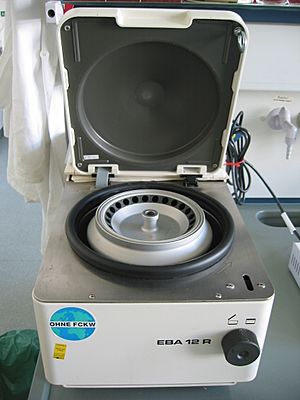Centrifuge facts for kids
A centrifuge is a special machine that spins things around very fast. Imagine spinning a bucket of water on a rope; the water pushes outwards. A centrifuge does something similar, but much more powerfully. It uses a force called centrifugal force to separate different parts of a mixture.
This machine works because of the sedimentation principle. This means that heavier or denser things in a mixture are pushed outwards by the spinning motion. At the same time, lighter or less dense things move towards the center. For example, in a lab centrifuge, if you spin a tube of liquid with tiny particles in it, the heavier particles will settle at the bottom of the tube. The lighter liquid will stay on top.
Centrifuges come in many sizes and are used for different jobs. Some are very large and used in factories. Others are small and found in science labs.
What Centrifuges Do
Centrifuges are used in many different ways. Here are some examples:
- Separating Liquids and Solids: In factories, large centrifuges can separate solid bits from liquids. They can also separate two liquids that don't mix, like oil and water. A good example is a cream separator used in dairies to separate cream from milk.
- Drying Clothes: The spin cycle in your washing machine is a type of centrifuge! It spins clothes very fast to push out the water, making them drier.
- High-Speed Separation: Very fast centrifuges, called ultracentrifuges, can separate tiny particles, even molecules, based on their weight.
- Training Astronauts: Large centrifuges are used to train astronauts. They spin them around to create a feeling of very high gravity, similar to what they might experience during a rocket launch.
- Separating Gases: Special machines called gas centrifuges are used to separate different types of gases. For example, they can separate different forms of uranium for nuclear fuel.
- Medical Tests: In hospitals and labs, centrifuges separate serum from blood samples. This helps doctors test for diseases.
- Chemical Experiments: Scientists use centrifuges to separate solid parts from liquid mixtures in chemical experiments.
History of Centrifuges
The idea of using spinning to separate things has been around for a long time. An English engineer named Benjamin Robins invented a spinning arm device in the 1700s. He used it to study how air affects moving objects.
Later, in 1864, a man named Antonin Prandtl suggested using a centrifuge to separate cream from milk. His brother, Alexander Prandtl, made this idea a reality. He improved the design and showed a working machine that could separate butterfat in 1875. This was a big step for the dairy industry!
Images for kids
See also
 In Spanish: Centrifugadora para niños
In Spanish: Centrifugadora para niños






